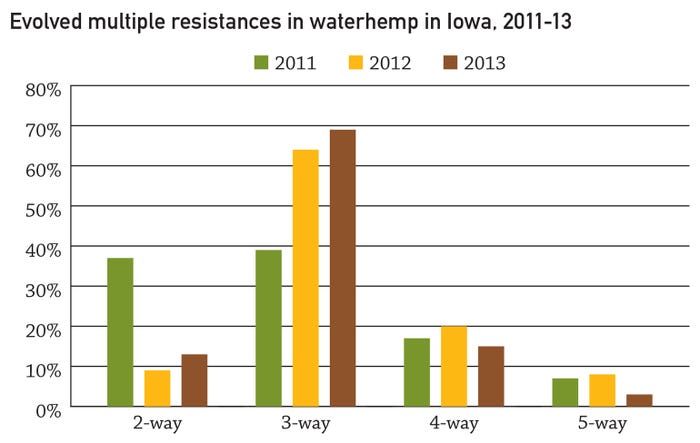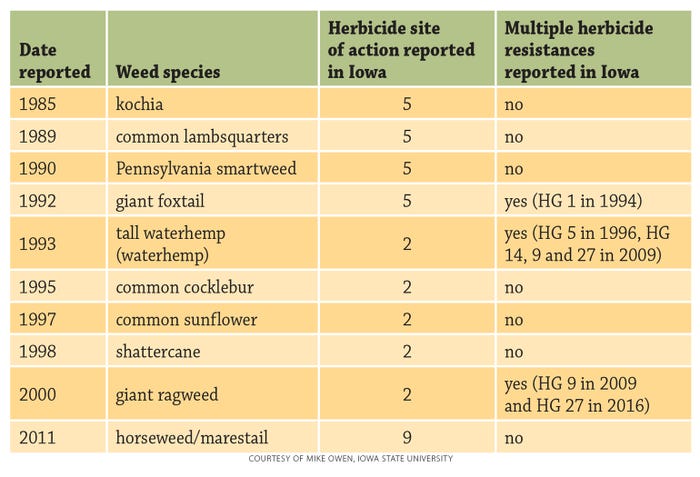February 8, 2018

Think Different.
Many farmers have begun to use multiple actions to combat herbicide resistance and are on the cusp of good weed management in Iowa, long-time weed scientist Mike Owen says. But, herbicide resistance continues to grow, and at an increasing rate. Multiple resistance is becoming the norm, with no new mode of action on the horizon for 15 to 20 years, Owen says more time, thought, and money will be needed to control weeds in the future.
Weed control in corn and soybeans will only get more complicated and costly.
That was a key message by long-time Iowa State University weed scientist Mike Owen in his 2018 weed management update presentation at the Integrated Crop Management Conference in November. He noted the management practices used by many farmers are leading to more resistance to herbicides, and he doesn’t foresee an end to that anytime soon.
“We’re at the cusp of good weed control in fields with good weed management, but multiple resistance is becoming the norm,” Owen said. “Tall waterhemp and giant ragweed have multiple herbicide resistances reported in Iowa, and they’re changing rapidly. We’ve recently begun seeing giant ragweed populations in north central Iowa—ragweed is the newest reported resistance in Iowa. Marestail is becoming more of a problem, and we have multiple resistances to giant foxtail.”
Owen said there are now 10 weed species with evolved herbicide resistance in the state. Along with the three that have multiple resistances–giant foxtail, waterhemp, and giant ragweed–other species with evolved resistance are kochia, common lambsquarters, Pennsylvania smartweed, common cocklebur, common sunflower, shattercane, and horseweed/marestail.
Weed samples prove resistance
At the request of the Iowa Soybean Association, Owen began a survey of soybean fields in Iowa in 2010 to gain a better understanding of the herbicide resistance problem. After sampling about 300 fields with weeds visible above the soybean canopy in August and September in 2011 and 2012, about 300 waterhemp populations were sampled again in 2013 across the state. The procedure used provides a prediction of herbicide resistance at a 95% confidence level.
Several female waterhemp plants were collected from each field. Samples were dried, seeds were threshed by hand, cleaned and wet-chilled, then air-dried, planted and grown in a greenhouse until the plants were 3-4 inches tall. They were then treated with an herbicide. Treatments included an HG 2 herbicide (Pursuit); an HG 5 herbicide (atrazine); an HG 9 herbicide (Roundup); an HG 14 herbicide (Cobra): and an HG 27 herbicide (Callisto). All herbicides were applied with adjuvants as suggested in the herbicide labels.
The herbicide groups included in the survey were chosen because they represent the most commonly used herbicides in Iowa. “The levels of herbicide resistance found were surprisingly high for the five herbicide groups evaluated,” Owen said, “but given the years these herbicides have been used in Iowa and the inevitability of evolved herbicide resistance, maybe it’s not that surprising,” he added.

On a global basis, weeds continue to gain resistance to herbicides.
“Based on the 2013 survey information, we would expect to find resistance to ALS-inhibitor herbicides (HG 2) in virtually all fields in Iowa. While only one ALS herbicide was used (Pursuit), waterhemp demonstrates cross-resistance to all HG 2 herbicides regardless of how it’s applied,” Owen said. “HG 2 herbicides are not effective in managing waterhemp in Iowa.”
Glyphosate resistance everywhere

Multiple herbicide resistances in Iowa waterhemp populations is the norm. Waterhemp populations with resistance to three herbicide groups increased over the course of this study, and in 2013 69% of the waterhemp populations demonstrated three-way resistance. This estimate is correct at the 95% confidence interval. Not surprising is the observation that the most common three-way resistance are for HG 2, HG 5, and HG 9, the most commonly used herbicide groups.
Owen said that based on the 2013 information, at the 95% confidence level, 97% of Iowa fields would also have detectable resistance to HG 5 (atrazine). After more than a decade of use on corn and soybean fields, glyphosate (HG 9, Roundup) resistance is likely in 98% of soybean fields in Iowa. “It’s unlikely glyphosate resistance will decline in waterhemp even if other technologies are adopted,” Owen said. The ISU study showed less than 20% of waterhemp populations were resistant to PPO inhibitor herbicides (HG 14, Cobra). “The HG 14 herbicides are seen as the only selective post-emergence option in soybeans, but with their increased use post-emergence and as soil-applied treatments, more waterhemp populations will become resistant,” Owen said. The final group sampled, HG 27 herbicides, (HPPD inhibitors such as Callisto) are the last new mechanism of action commercially introduced, having been widely used in corn for 30 years. The ISU survey showed less than 40% of the waterhemp populations are resistant, but Owen thinks the figures are underestimated, since use of HG 27 herbicides has been increasing since 2013.
Looking ahead
“One problem with waterhemp is that the resistance trait is likely to be conserved even if the herbicide isn’t used,” Owen said. “Aaron Hager (University of Illinois) sprayed 2,4-D and dicamba on a waterhemp field in Illinois for the first time, and found waterhemp was resistant to them, even though that field had never been sprayed with them. Evolved multiple resistances in waterhemp will make it a challenge to know which herbicide mechanisms of action are still effective. I know farmers want a new herbicide, but it’s impossible to spray the problem of herbicide resistance in waterhemp away. The solution is judicious use of herbicides and adoption of greater diversity of weed management tactics.”
The future for weed control in soybeans isn’t very bright right now, Owen said. Dicamba drift/volatilization will likely help waterhemp build resistance to dicamba, for instance. Add Palmer Amaranth to the mix of waterhemp issues, too. “You could probably find Palmer Amaranth problems of some kind in every county in Iowa now. It will move from conservation plantings into crop fields. I don’t think it will go away,” Owen says, “because I don’t see the diligence required to make it go away.”
“Despite what product marketing might suggest, there are no simple and convenient answers to weed management. It has to move beyond spraying a herbicide. That requires more time, thought, and money to control weeds, but it’s best to do that before you have a train wreck and weeds get out of control.”
Check the resistant weeds in your state.

In Iowa, weed species continue their evolution to resist more herbicides.
About the Author(s)
You May Also Like




